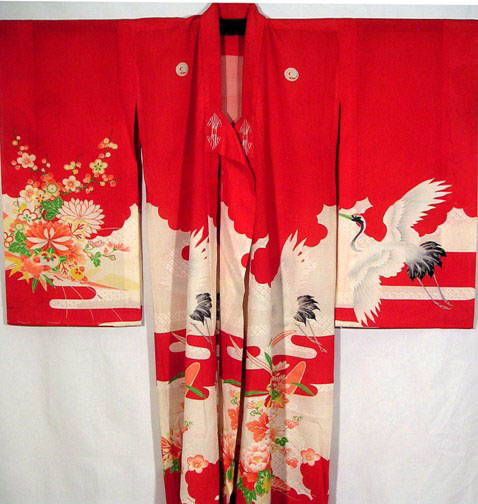Description
This is one of the best examples of a young girl’s Formal Kimono – bright, colorful and cheerful. It has been hand woven of “Summer Silk” which, according to the rules of the Japanese dress code, could only have been worn in 3 of the summer months: June, July and August. The brilliant motif has been hand painted in the traditional Yuzen process using a variant of the “Rice Paste Resist” technique in a design that includes many auspicious symbols: the Crane (“Tsuru”) which represents good fortune and, oftentimes, longevity as legend has it that it takes the Crane 1000 years to fly to the sun; the stylized Pine (“Matsu”) which reinforces the desire for long life; the drifting Clouds (“Kumo”) which carry the significance of elegance and high status; and the Chrysanthemums (“Kiku”) which have long been associated with the Imperial Family. Because of the strong red background color, the design is much more prominent. In the Orient, red has often been associated with the ritual (many bridal costumes are red) of the warding off of evil. It is also considered a color of excitement and passion and has become such an important part of everyday Japanese life that it is the color of their personal signature or seal.
Each of the images, however, goes a step beyond the “Tsutsugaki” or Rice Paste Resist process, a technique that required each color be applied separately, while all the others were painted out in the rice paste. Each time a new color was added, the rice paste had to be removed by soaking it out over and over again in the local river water. The Rice Paste Resist method of Yuzen, is a masterful and complicated method that builds on the Tsutsugaki process. It results in a distinguishing, thin white outline around each element in the design. This is an astonishingly difficult, time consuming, and labor-intensive process that could only have been accomplished by a very talented painter.
The Family Crest (“Mon”) appears 5 times on the shoulders and back of the garment and indicates that it was to be worn for formal occasions. The Crest is that of the Water Plantain (“Omodaka”) encircled by one of the most graceful and intricate of the traditional Japanese design motifs, the Wisteria or “Fuji.” The Water Plantain is also known as the “Shogunso” or Victory Plant and is wildly admired in Japan. It is obvious that this Kimono could only have belonged to a young woman of high social standing and wealth as portrayed by the fabric, the design and the family crest.
A Certificate of Authenticity is included.
TTAC will personally pack and ship via UPS at company expense within the continental U.S.









